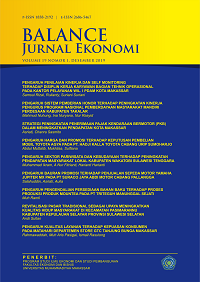Effect Cashless Payment on Inflation with Velocity of Money as Intervening Variable
DOI: https://doi.org/10.26618/jeb.v18i2.9606
Credit cards, debit cards, electronic money, inflation and velocity of money.
Abstract
This study aims to examine the effect of debit cards, credit cards, e-money on inflation and the velocity of money as an intervention. Data in this study were obtained from trusted sources and the official websites of BI and BPS for the 2016-2020 period. The research data is secondary data in the form of time series data. This research uses the method of path analysis or path analysis and the data will be processed using SPSS. Test methods include classical assumption test, hypothesis test and test of the coefficient of determination R^2. The significance level of this study is 5%. The results of this study state that in the first equation directly e-money has no significant effect on the velocity of money but credit cards and debit cards have a significant effect on the velocity of money, in the second equation directly debit cards and e-money have no effect on inflation, while credit cards and the velocity of money have a significant influence on inflation, indirectly the velocity of money is able to be an intervening between credit cards, debit cards, and e-money on inflationReferences
Abednego Priyatama, & Apriansah. (2010). Correlation Between Electronic Money and the Velocity of Money. Global Management Conference, 11, 1–6.
Arewa, A., & Nwakanma, P. C. (2013). Money Supply and Velocity of Money in Nigeria : A Test of Polak Model. Journal of Management and Sustainability, 3(4), 136–150. https://doi.org/10.5539/jms.v3n4p136
Gujarati, D. N. (2003). 20Basic Econometrics Gujarati (fourth edi). Tata Mcgraw Hill.
Gujarati, D. N., & Porter, D. C. (2009). Basic Econometrics (fifth edit). Mc. Graw Hill.
Geanakoplos, J., & Dubey, P. (2011). CREDIT CARDS AND INFLATION, Games and Economic Behavior. Elsevier, 1330. https://doi.org/10.1016/j.geb.2010.02.004
Kalbuadi, K., Yanthi, M. D., & Surabaya, U. N. (2021). ANALISIS PENGARUH PELUNCURAN SISTEM E-MONEY DAN JUMLAH UANG BEREDAR. Akuntansi, Jurnal Cendekia, 2(1), 11–23.
Lukmanulhakim, M., & Djambak, S. (2016). Pengaruh transaksi non tunai terhadap velositas uang di Indonesia. Jurnal Ekonomi Pembangunan (JEP), 14(1), 41–46.
Mankiw, N. G. (2007). Macroeconomics (seventh ed). worth publishers. www.worthpublishers.com
Mishkin, S. F. (2008). The economics of money, banking, and financial markets (Fourth Can). Pearson.
Popovska-Kamnar, N. A. (2014). www.econstor.eu. Econstor.
Pelletier, A., Khavul, S., & Estrin, S. (2020). Innovations in emerging markets : the case of mobile money. Industrial and Corporate Change Oxford, 29(2), 395–421. https://doi.org/10.1093/icc/dtz049
Rahmawati, Juliprijanto, W., Jalunggono, G., Ekonomi, F., & Tidar, U. (2018). ANALISIS PENGARUH E-MONEY TERHADAP PERPUTARAN. DINAMIC : Directory Journal of Economic, 2.
Safitri, A., & Ariza, A. (2021). Pengaruh Pembayaran Non Tunai , Velocity of Money dan Suku Bunga Terhadap Inflasi di Indonesia. Prosiding Seminar Nasional SATIESP, 94–105.
Solikin, & Suseno. (2002). UANG (Issue 1). Pusat Pendidikan dan Studi Kebanksentralan (PPSK) BI.
Syarifuddin, F., Hidayat, A., & Tarsidin. (2009). Dampak peningkatan pembayaran non-tunai terhadap perekonomian dan implikasinya terhadap pengendalian moneter di indonesia. Buletin Ekonomi Moneter Dan Perbankan, 369–402.
Widyanita, A. T. (2018). DAMPAK ALAT TRANSAKSI NON TUNAI BERBASIS KARTU TERHADAP TINGKAT INFLASI DI INDONESIA PADA TAHUN 2010-2016. Jurnal Ilmiah.
Yuwono, L. C. A. (2017). ELEKTRONIK TERHADAP INFLASI DI INDONESIA TAHUN 2009-2016. Jurnal Ilmiah.












